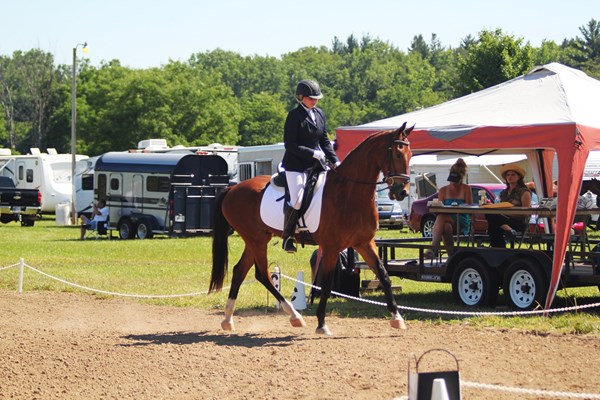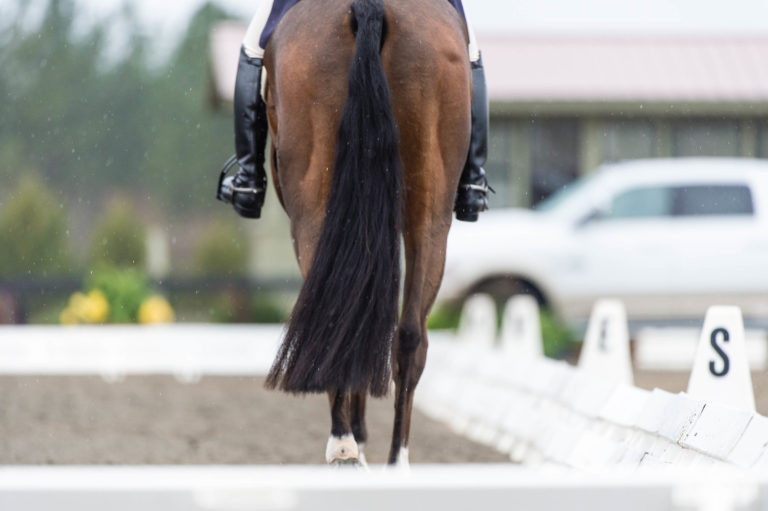
This picture shows 17-year-old Ashley Pooler on her 3-year-old Dutch Harness gelding, I-Ronic (“Nic”), at their first show. The pair competed at Training Level, and Ashley describes her horse as very excited and overmotivated, but all in all, a good boy. She was very proud of him.
At an early age, Nic already appears to be very tall and long-legged. Just like in the case of a growing teenager, his coordination and balance will take some time to develop. The picture clearly shows his excitement and is also a good example of how nervousness can lead to flashy but tense movements, which you can see in Nic’s legs. He is behaving himself, but it seems that he cannot help but glance over at the judges’ tent, which is revealed by the slight tilt in his neck and the tension in the shoulders. This tension is also limiting the reach of his forehand. The way he is lowering his croup and angling his hind leg shows great mobility. In many cases, young, tall horses are overmobile and it takes time for them to develop coordination and strength. Working on good basics and establishing clear rhythm will be necessary for Nic to find better balance and calmness within his own movement.
Ashley is very focused and it appears that she is mainly busy with controlling her mount and not yet truly showing him. That’s very understandable for this situation. Even though the horse is clearly a bit tense, she is not pulling on the reins. However, she does hold her right hand a bit high up and in a backward direction. This must be noted because this hand position creates more tension in her own body and shoulders. Remember that horses have more vision to the side and can see the riders’ hands, just as we can see the corner of their inside eye. The horse cannot see the length of the rein, but he learns very quickly what a backward-moving hand could mean and, therefore, will not dare to stretch into the contact.
Especially in moments of tension it is important for Ashley to keep her hand low with a forward tendency in her arm so that Nic will learn to trust her and relax his poll and topline more to follow the contact. This should develop into a consistent, even contact as they move up the levels. Remember that even when the horse has developed a level of self-carriage, contact is still necessary.
To work on developing more consistent contact and to help relax her horse, I advise Ashley to try this: Ride on a 20-meter circle, concentrating on four half-halt points that are evenly distributed around the circle. On a 20-meter circle at C in a 20-by-40 arena, these points are at C, the two touching points on the long side 10 meters from the corner and X. Each of the half-halt points should be approached and prepared for by ensuring that the horse is balanced and accepting the outside aids. Then, Ashley can use her inside leg a bit more when turning at each of those points. After using her inside leg, she should make sure she releases the inside rein without giving up on the inside flexion. She should try giving her hand forward so that Nic will understand to stretch more into the contact of the outside rein. Most horses learn very quickly that the use of the inside leg will be followed by giving on the inside rein and, thus, they will be able to balance better coming around each turn or later out of the corners. It is always important to remember that giving is the most important moment of the half halt.
I also see that Ashley is looking down. This often happens when intense concentration is needed. The advice I want to give Ashley is to look more ahead to the next movement. On the circles she should always focus on the next quarter of the circle. Looking ahead helps to shift the rider’s weight toward the correct direction and gives the horse better security in the balance.
Looking again at the horse, notice how Nic is carrying his neck a little too high for Training Level and is not working into a steady contact. Another helpful tool is to visualize a triangle formed between the horse’s mouth and each of the rider’s hands. The reins and the space between the rider’s hands represent the sides of the triangle. When working with young horses, opening this triangle a little wider by widening your hands helps both horse and rider find better balance. Just as when you are standing, it is easier to balance with your legs farther apart than closer together. A wider base allows easier balance, while a narrower base challenges the balance. The same is true for the contact. A wider triangle allows the horse a better balance between the inside and outside reins and makes it easier for the horse to reach to the contact. With a more secure contact, the triangle can become narrower with the hands closer together. In this task Ashley will be able to feel a better interplay between her inside and outside rein and learn to feel how the contact can support—not restrict—Nic’s movement.
I wish her all the best in this exciting challenge of bringing a young horse along.
You can submit your high-resolution dressage photo for critique (300 dpi and 4 by 6 inches in size). Or you can send your photo with a link to a short video. Email to DressageToday@AimMedia.com. Turnout in dressage show or clinic-appropriate attire is encouraged. Don’t forget your helmet!











